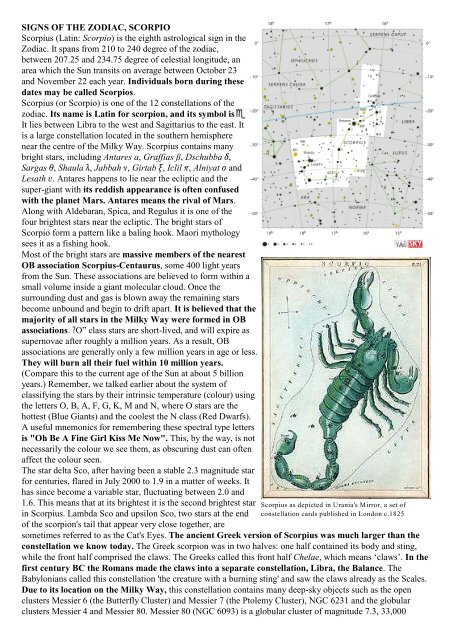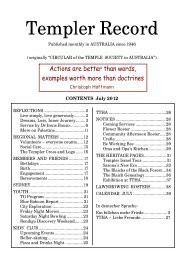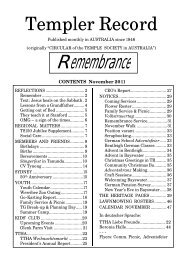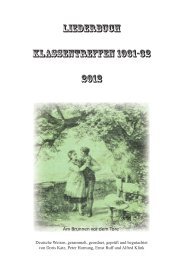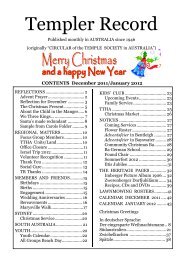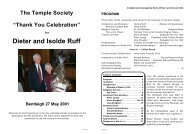Signs of the Zodiac: Scorpio - temple society australia
Signs of the Zodiac: Scorpio - temple society australia
Signs of the Zodiac: Scorpio - temple society australia
You also want an ePaper? Increase the reach of your titles
YUMPU automatically turns print PDFs into web optimized ePapers that Google loves.
SIGNS OF THE ZODIAC, SCORPIO<br />
Scorpius (Latin: <strong>Scorpio</strong>) is <strong>the</strong> eighth astrological sign in <strong>the</strong><br />
<strong>Zodiac</strong>. It spans from 210 to 240 degree <strong>of</strong> <strong>the</strong> zodiac,<br />
between 207.25 and 234.75 degree <strong>of</strong> celestial longitude, an<br />
area which <strong>the</strong> Sun transits on average between October 23<br />
and November 22 each year. Individuals born during <strong>the</strong>se<br />
dates may be called <strong>Scorpio</strong>s.<br />
Scorpius (or <strong>Scorpio</strong>) is one <strong>of</strong> <strong>the</strong> 12 constellations <strong>of</strong> <strong>the</strong><br />
zodiac. Its name is Latin for scorpion, and its symbol is<br />
It lies between Libra to <strong>the</strong> west and Sagittarius to <strong>the</strong> east. It<br />
is a large constellation located in <strong>the</strong> sou<strong>the</strong>rn hemisphere<br />
near <strong>the</strong> centre <strong>of</strong> <strong>the</strong> Milky Way. Scorpius contains many<br />
bright stars, including Antares a, Graffias ß, Dschubba δ,<br />
Sargas θ, Shaula λ, Jabbah ν, Girtab ξ, Iclil π, Alniyat σ and<br />
Lesath υ. Antares happens to lie near <strong>the</strong> ecliptic and <strong>the</strong><br />
super-giant with its reddish appearance is <strong>of</strong>ten confused<br />
with <strong>the</strong> planet Mars. Antares means <strong>the</strong> rival <strong>of</strong> Mars.<br />
Along with Aldebaran, Spica, and Regulus it is one <strong>of</strong> <strong>the</strong><br />
four brightest stars near <strong>the</strong> ecliptic. The bright stars <strong>of</strong><br />
<strong>Scorpio</strong> form a pattern like a baling hook. Maori mythology<br />
sees it as a fishing hook.<br />
Most <strong>of</strong> <strong>the</strong> bright stars are massive members <strong>of</strong> <strong>the</strong> nearest<br />
OB association Scorpius-Centaurus, some 400 light years<br />
from <strong>the</strong> Sun. These associations are believed to form within a<br />
small volume inside a giant molecular cloud. Once <strong>the</strong><br />
surrounding dust and gas is blown away <strong>the</strong> remaining stars<br />
become unbound and begin to drift apart. It is believed that <strong>the</strong><br />
majority <strong>of</strong> all stars in <strong>the</strong> Milky Way were formed in OB<br />
associations. ?O” class stars are short-lived, and will expire as<br />
supernovae after roughly a million years. As a result, OB<br />
associations are generally only a few million years in age or less.<br />
They will burn all <strong>the</strong>ir fuel within 10 million years.<br />
(Compare this to <strong>the</strong> current age <strong>of</strong> <strong>the</strong> Sun at about 5 billion<br />
years.) Remember, we talked earlier about <strong>the</strong> system <strong>of</strong><br />
classifying <strong>the</strong> stars by <strong>the</strong>ir intrinsic temperature (colour) using<br />
<strong>the</strong> letters O, B, A, F, G, K, M and N, where O stars are <strong>the</strong><br />
hottest (Blue Giants) and <strong>the</strong> coolest <strong>the</strong> N class (Red Dwarfs).<br />
A useful mnemonics for remembering <strong>the</strong>se spectral type letters<br />
is "Oh Be A Fine Girl Kiss Me Now". This, by <strong>the</strong> way, is not<br />
necessarily <strong>the</strong> colour we see <strong>the</strong>m, as obscuring dust can <strong>of</strong>ten<br />
affect <strong>the</strong> colour seen.<br />
The star delta Sco, after having been a stable 2.3 magnitude star<br />
for centuries, flared in July 2000 to 1.9 in a matter <strong>of</strong> weeks. It<br />
has since become a variable star, fluctuating between 2.0 and<br />
1.6. This means that at its brightest it is <strong>the</strong> second brightest star<br />
in Scorpius. Lambda Sco and upsilon Sco, two stars at <strong>the</strong> end<br />
<strong>of</strong> <strong>the</strong> scorpion's tail that appear very close toge<strong>the</strong>r, are<br />
Scorpius as depicted in Urania's Mirror, a set <strong>of</strong><br />
constellation cards published in London c.1825<br />
sometimes referred to as <strong>the</strong> Cat's Eyes. The ancient Greek version <strong>of</strong> Scorpius was much larger than <strong>the</strong><br />
constellation we know today. The Greek scorpion was in two halves: one half contained its body and sting,<br />
while <strong>the</strong> front half comprised <strong>the</strong> claws. The Greeks called this front half Chelae, which means ‘claws’. In <strong>the</strong><br />
first century BC <strong>the</strong> Romans made <strong>the</strong> claws into a separate constellation, Libra, <strong>the</strong> Balance. The<br />
Babylonians called this constellation '<strong>the</strong> creature with a burning sting' and saw <strong>the</strong> claws already as <strong>the</strong> Scales.<br />
Due to its location on <strong>the</strong> Milky Way, this constellation contains many deep-sky objects such as <strong>the</strong> open<br />
clusters Messier 6 (<strong>the</strong> Butterfly Cluster) and Messier 7 (<strong>the</strong> Ptolemy Cluster), NGC 6231 and <strong>the</strong> globular<br />
clusters Messier 4 and Messier 80. Messier 80 (NGC 6093) is a globular cluster <strong>of</strong> magnitude 7.3, 33,000
light-years from Earth. It is a<br />
compact Shapley class II cluster;<br />
<strong>the</strong> classification indicates that it<br />
is highly concentrated and dense<br />
at its nucleus. M80 was<br />
discovered in 1781 by Charles<br />
Messier. It was <strong>the</strong> site <strong>of</strong> a rare<br />
discovery in 1860 when Arthur<br />
von Auwers discovered <strong>the</strong> nova<br />
T Scorpii. It had not been since.<br />
Recently, astronomers studying<br />
stellar populations in M80 in <strong>the</strong><br />
ultraviolet, using <strong>the</strong> HST, were<br />
able to identify most <strong>of</strong> <strong>the</strong><br />
known x-ray sources in <strong>the</strong> core<br />
<strong>of</strong> <strong>the</strong> cluster. While <strong>the</strong> main<br />
point <strong>of</strong> <strong>the</strong>ir investigation was to study <strong>the</strong> populations <strong>of</strong> Blue Straggler Stars, one <strong>of</strong> <strong>the</strong>se sources happened<br />
to be a dwarf nova in outburst at <strong>the</strong> time <strong>of</strong> <strong>the</strong> observations. More interesting than that, it appears to be<br />
consistent with <strong>the</strong> location <strong>of</strong> <strong>the</strong> 1860 nova, T Scorpii. Given its position, X-ray and UV brightness and<br />
variability, this source is almost certainly <strong>the</strong> true counterpart to T Sco. After 150 years an old friend was<br />
finally found again.<br />
In Greek Mythology <strong>the</strong> myths associated with<br />
<strong>Scorpio</strong> almost invariably also contain a reference to<br />
Orion. According to one <strong>of</strong> <strong>the</strong>se myths it is written<br />
that Orion boasted to goddess Artemis and her<br />
mo<strong>the</strong>r, Leto, that he would kill every animal on <strong>the</strong><br />
earth. Although Artemis was known to be a hunter<br />
herself she <strong>of</strong>fered protection to all creatures.<br />
Artemis and her mo<strong>the</strong>r Leto sent a scorpion to deal<br />
with Orion. The pair battled and <strong>the</strong> scorpion killed<br />
Orion. However, <strong>the</strong> contest was apparently a lively<br />
one that caught <strong>the</strong> attention <strong>of</strong> Zeus, who <strong>the</strong>n raised<br />
<strong>the</strong> scorpion to heaven and afterwards, at <strong>the</strong> request<br />
<strong>of</strong> Artemis, did <strong>the</strong> same for Orion to serve as a<br />
reminder for mortals to curb <strong>the</strong>ir excessive pride. So<br />
every winter Orion hunts in <strong>the</strong> sky, but every<br />
summer he flees as <strong>the</strong> constellation <strong>of</strong> <strong>the</strong> scorpion<br />
rises.<br />
In ano<strong>the</strong>r Greek story involving <strong>Scorpio</strong> without<br />
Orion, Phaeton (<strong>the</strong> mortal male <strong>of</strong>fspring <strong>of</strong> Helios)<br />
went to his fa<strong>the</strong>r, who had earlier sworn by <strong>the</strong> River<br />
Styx to give Phaeton anything he should ask for.<br />
Phaeton wanted to drive his fa<strong>the</strong>r's Sun Chariot for a day.<br />
Although Helios tried to dissuade his son, Phaeton was<br />
adamant. However, when <strong>the</strong> day arrived, Phaeton panicked<br />
and lost control <strong>of</strong> <strong>the</strong> white horses that drew <strong>the</strong> chariot.<br />
First, <strong>the</strong> Earth grew chill as Phaeton flew too high and <strong>the</strong>re<br />
encountered <strong>the</strong> celestial scorpion, its deadly sting raised to<br />
strike. Alarmed, he dipped <strong>the</strong> chariot too close to <strong>the</strong> Earth,<br />
causing <strong>the</strong> vegetation to burn. By accident, Phaeton turned<br />
most <strong>of</strong> Africa into desert and darkened <strong>the</strong> skin <strong>of</strong> <strong>the</strong><br />
Ethiopian nation until it was black. Eventually, Zeus was<br />
forced to intervene by striking <strong>the</strong> runaway chariot and<br />
Phaeton with a lightning bolt to put an end to its rampage and<br />
Phaeton plunged into <strong>the</strong> River Eridanos. AK<br />
Scorpius from <strong>the</strong> Uranographia <strong>of</strong> Johann Bode (1801). Part <strong>of</strong> <strong>the</strong><br />
scorpion’s body is overlapped by <strong>the</strong> foot <strong>of</strong> Ophiuchus. In <strong>the</strong><br />
middle <strong>of</strong> <strong>the</strong> scorpion’s body lies <strong>the</strong> red star Antares. On this chart,<br />
Bode also gives Antares <strong>the</strong> alternative name Calbalacrab, from <strong>the</strong><br />
Arabic meaning ‘scorpion’s heart’


